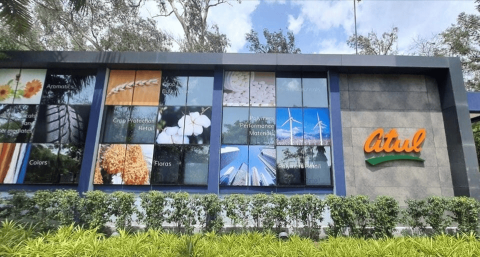Atul Limited Share Price Target at Rs 8,300: Anand Rathi Research
Atul Limited is on the cusp of a structural re-rating as capacity utilization ramps up and deferred capex begins to bear fruit. In a recent note, Anand Rathi assigned a Buy rating with a 12-month target price of Rs 8,300, projecting a 30x FY27e EPS valuation. With capital expenditure of over Rs 20bn in the last three years—matching investments from the prior decade—the company now sits on Rs 25bn in unrealized sales potential. The combination of enhanced competitiveness, export tailwinds, and a robust product pipeline across specialty chemicals and life sciences paints a compelling picture for investors.
Capex Converts into Capacity: Rs 25bn in Unrealized Sales Awaits Monetization
Atul invested Rs20bn over the past three years in brownfield and greenfield capacity expansion, unlocking a pipeline of Rs25bn in potential revenues. Of this, Rs17bn is tied to new projects, while Rs8bn stems from underutilized assets. With technical glitches resolved and regulatory approvals in motion, monetization is now imminent.
The company expects to achieve revenue, EBITDA, and PAT CAGRs of 15%, 20%, and 30%, respectively, over FY25–27. Key areas of expansion include 2,4-D, resorcinol, epoxy, and pharma intermediates—all of which have tailwinds from demand recovery and global supply chain recalibration.
Export-Led Segments Show Competitive Edge Over China
Atul is capitalizing on market-share gains in export-intensive verticals such as sulfones, 2,4-D, and pharma intermediates. The U.S. Department of Commerce has levied a 127.71% antidumping duty (ADD) on Chinese 2,4-D, compared to just 25.85% on Atul, significantly improving its export competitiveness.
In epoxy resins, where margins were under pressure in FY24, the downside now appears capped. The company expects growth as Indian exports face the lowest tariffs in U.S. markets. With specialty sulfones commissioned and new geographies targeted—including Africa, LATAM, and the Middle East—export visibility remains robust.
Strong Balance Sheet and Cash Flows Fuel Expansion
Atul remains debt-free, holding Rs6.8bn in cash and expecting internal accruals of Rs18bn over FY26–27. Small but high-ROI investments are underway, including Rs0.4bn in aromatics with Rs0.7–0.8bn revenue potential. Capex will now shift from large expansions to debottlenecking and backward integration.
Anaven (JV with Nouryon) and Atul Bioscience (100% subsidiary) are both poised for scale. Anaven is central to Atul's strategy for MCA integration and will reduce reliance on external vendors, improving cost structures and enhancing control over 2,4-D supply.
Strong Segmental Momentum Across Crop Protection and Pharma
In bulk crop protection, Atul has reclaimed global share in 2,4-D (13%) and Indoxacarb (15%), thanks to improved plant uptime and competitive pricing. Retail crop protection grew 36% in volume terms with 10 new products launched in FY25. The patented product "Sindica" saw a 122% rise in volumes.
In pharmaceuticals, revenue rebounded 31% YoY post-FY23 disruptions. Dapsone remains a global leader, and new APIs under registration promise to diversify revenue streams. The company completed its third U.S. FDA audit with zero observations—critical for future approvals.
Colorants, Polymers, and Epoxy Drive Margin Expansion
Colors posted 15% growth with 17% volume gains, led by demand from textiles and coatings. Expansion into high-performance pigments (HPP) aims at gaining wallet share from the paints and coatings sector. The Rudolf Atul JV posted 23% volume growth, strengthening its domestic footprint.
Polymers and performance materials—especially epoxy resins—are experiencing margin improvement. With global epoxy demand projected to reach Rs1.5trn, Atul is well placed in coatings, composites, and electronics segments. The company’s Rs7.7bn–8bn unrealized sales potential in this segment could materialize over the next 2–3 years.
Financial Performance and Forecast
FY25 saw a recovery across key metrics: Revenue rose 18%, EBITDA increased 43%, and RoCE improved by 300bps. The caustic chlorine project under the Gujarat government’s incentive scheme added Rs1.5bn in debt at an effective 2% rate. EBITDA margins improved from 9.5% in FY24 to 12.6% in FY25.
Atul expects continued operating leverage benefits, helped by volume ramp-ups, price stability, and capacity unlocks. Treasury income, stable working capital, and margin tailwinds set the stage for higher free cash flows in FY26 and FY27.
| Metric | FY25 | FY26e | FY27e |
|---|---|---|---|
| Revenue (Rs bn) | 55.8 | 64.3 | 73.8 |
| EBITDA (Rs bn) | 9.1 | 11.0 | 13.1 |
| PAT (Rs bn) | 4.8 | 6.6 | 8.2 |
| EPS (Rs) | 174.2 | 224.4 | 277.3 |
| RoCE (%) | 10.7 | 12.7 | 14.6 |
| EV/EBITDA (x) | 21.5 | 17.2 | 14.0 |
| Net Debt/Equity | -0.3 | -0.4 | -0.4 |
Valuation and Risks
Anand Rathi resumes coverage with a "Buy" rating and a target price of Rs8,300, implying a 21% upside from the current Rs6,859 level. Valuation is based on a 30x FY27e EPS multiple, reflecting strong execution, backward integration, and scalable global relevance in key verticals.
Key Risks include:
Trade policy headwinds and export dependency
Ramp-up delays in commercialized units
Price volatility in non-U.S. markets
Delays in regulatory approvals
Global slowdown affecting key sectors like agrochemicals and pharmaceuticals
Conclusion: Positioned for a Structural Rerating
Atul Ltd. has transformed its balance sheet, unlocked capacity, and deepened vertical integration—all setting the stage for margin accretion and superior returns. With favorable macro tailwinds, rising global competitiveness, and expanding product lines, the company is poised to outperform across business cycles. For investors seeking structural compounders in India’s specialty chemicals domain, Atul is a name to watch.
